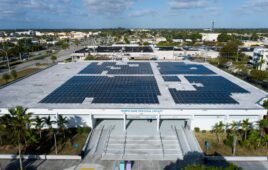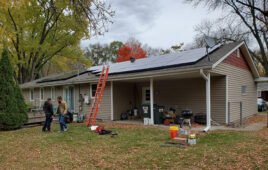UPDATE 12/16/2022: The CPUC voted unanimously to approve the new net-billing plan.
After over a year of debate and numerous iterations, the California Public Utilities Commission (CPUC) has released its final proposal for the state’s next phase of the net-metering program and will hold a vote today, Dec. 15, at 11 a.m. PT.
When solar arrays produce more energy than a home or business needs, the owner can put some of that energy back onto the grid and receive compensation. The CPUC has been deliberating on the next phase of California’s compensation program since 2020.
The new plan is a shift to net billing, which differs from net metering because customers are selling energy back to the utility at lower “avoided cost” or wholesale rates (what the utility pays for energy), rather than the higher retail rates (what utility customers pay for energy) that are paid in net-metering programs, according to EnergySage.
The CPUC made minimal revisions to the previous proposal in the final proposed decision. Here are the main points in the final proposed decision the CPUC will vote on today:
- New net-billing structure that features base hourly export compensation rates with a different 24-hour profile for each month and for weekends vs. weekdays. These also vary by utility, but all three average out to be around 3¢/kWh, down from 30¢/kWh on average, according to CALSSA
- Five-year “glide path” with a 75% average decrease of exported energy value from NEM 2.0 in Year 1, according to CALSSA
- Residential customers in PG&E and SCE territory receive avoided cost “adders” starting at 2 to 4¢/kWh to create this glide path. The adders decrease by 20% annually until they reach zero. In the final proposed decision, the PG&E adder was increased by less than half a cent, but others stayed the same
- The ruling excludes SDG&E customers from receiving any adders because the CPUC says their solar systems will pay off in less than nine years due to SDG&E’s higher electricity rates
- Commercial customers do not receive adders or glide path
- Revised final decision preserves current value of solar for multi-family housing (Virtual Net Energy Metering or VNEM) and farms (NEM aggregation or NEMA)
- Those who apply for VNEM before April 15, 2023, will remain under NEM 2.0 for 20 years, but new projects after that will remain under 2.0 for nine years before transitioning to a future tariff that will be determined from a multifamily specific workshop in 2023
- No later than 120 days from this vote, Net Metering 2.0 sunset will be implemented. Customers that complete an interconnection application before that period will remain under NEM 2.0
- Customers that file interconnection applications before NEM 2.0 sunset are required to submit final building permit sign-off within three years to remain under NEM 2.0
- NEM 1.0 and 2.0 customers will remain under their programs unchanged

The California Solar & Storage Association (CALSSA) issued a press statement expressing its displeasure with the proposal.
“The CPUC’s final proposal is a loser for California on many levels,” said Bernadette Del Chiaro, executive director of CALSSA. “For the solar industry, it will result in business closures and the loss of green jobs. For middle-class and working-class neighborhoods where solar is growing fastest, it puts clean energy further out of reach. For our grid reliability needs, it fails to promise robust growth in battery storage. And for California’s race to clean energy, it puts us behind our goals and out of step with the national pro-solar agenda. The proposal is a step backwards when we really need to be moving forward with solar and battery storage. It is a dark day in California when the utility regulators try to block out the sun.”
Click here for call-in information for the CPUC’s voting meeting.
Updated on Dec. 19 to add details on VNEM decision





Lots of valid complaints here albeing good and accurate! What is the action plan/solution?
– Protests in Sacramento?
– Flood Newsom’s office with complaints?
– Protests at local representative offices?
– Civil disobiedience – (mass witholding of partial utility payments/taxes)?
– Solicit Edison competators?
– Lobby for transition to public utilities?
– Challenge constitutionality of state laws on required use of utilities?
This is not the end all for new customers. As the utility rates continue to climb (SDGE by 20% kW rate starting 1/23); still the best way to save money and add value to your home is to get solar. If your reason for going solar is to make money at the end of the year in True-up then your needs are different than most. Sure NEM 3.0 is straight up ROBBERY, but until there is action made to stop monopolies from doing what they do, this is Commifornia.
More proof the CPUC is in the pocket of the utilities. For a state that has an energy problem, this will kill new solar in CA. Effectively doing the opposite of what they preach. Thank god I’m locked into NEM 2.0. Hope I never have to move.
Who wrote the proposal? Utilities? or CPUC STAFF? Did they speak with the Energy Commission folks? Did they confer with CARB staff who wrote regulations banning the sale of new gasoline powered cars in 2035? I don’t see how CA IS going TO HAVE ENOUGH ELECTRICITY TO POWER ALL THOSE EVs without more tooftop solar This is bad governance – the left hand not knowing what the right hand is doing!
Melanie Marty
There has never been a retail value for excess power onto the grid.. Any solar customer that has been on NEM1.0 or 2.0 can tell you that they have never received retail value for power sent onto the grid..
Sdge steals that energy.. they are going to tell me that they don’t profit,. I say Bullshit!
Then why are the utilities scrambling to install battery systems to suck up the power during the day only to sell back to us at night? Now the CPUC has played right into the Utilities hand.. They now get free power into the battery storage systems and pull in more profit than before.. Are you saying that we would have cheaper electric bills for all users if there was no solar? I say Bullshit! Again!
Nothing you do is going to stop For-Profit entities from trying to make profits off of homes..
I’ve had solar for 20 years. The first year I over generated $500 of electricity only to have sdge pay me $85.. They converted my credits back into kWhs and paid .05 cents.. I bought a jacuzzi and added a swimming pool to suck up all my own energy..
I’ve added a battery system and now have a $1 bill average per month..
That’s the best we will get.. Don’t forget there is a 1890 law that will not allow you to disconnect from the grid.. This too shall pass.. I hope..
Batteries are much better today and with appliances in the future will have built in battery charging for evening usage.. Technology is our saving grace..
Not sure what this is about. Have had solar with PGE since 2002. NM1 now is NM2. PGE always paid 3 to 4 c per Kwh at each yearly trueup. Am using TOU-D. I guess some have been getting a return similar to what they would have paid if consumed? I can see where that would be a problem if not paying a fair share of the xmission line cost that allows them to be connected.
It is becoming a new era of use and abuse of electricity that has been “anointed” by the very entity the CPUC that is supposed to protect residential electricity users from usury. Forcing home owners into solar PV + energy storage to offset the distributed residential solar PV generation system’s lousy 3 cents per kWh of overgeneration sent back to the grid. One is better off keeping as much of the daily energy generation as possible and time shift this for use when the local utility invokes a TOU rate spiking period after the sun goes down. The interactive micro-grid is becoming an expensive but attractive option in California. It’s starting to look like the “programs” for energy in California will sweep across the U.S. and within a decade the majority of the country may be paying on average $0.25/kWh bundled retail.
Regarding the question I asked – Found it in the final decision!
(f) Step 6: Three years from the application submission, all
customers seeking to interconnect to the NEM 2.0 tariff
shall submit final building permit sign off and electrical
clearing by the authority having jurisdiction. Pacific Gas
and Electric Company, San Diego Gas & Electric Company
and Southern California Edison Company have the
discretion to apply NEM 2.0 eligibility to customers who
fail to meet this deadline due to utility-caused delays.
13. Rulemaking 20-08-020 remains open to address outstanding issues in the
Scoping Memo and continuing matters related to this decision.
Can you tell me where you found “Customers that file interconnection applications before NEM 2.0 sunset are required to submit final building permit sign-off within three years to remain under NEM 2.0”? I don’t see it anywhere.
Thanks,
Pete
Yes its there.
It’s alright, we should be able to live on Mars in about 40 years. Forget Earth. Big money is going to extract everything from Mother Nature while it can so which ever little boy has the most money wins.
Thank you for the straight-forward reporting on this issue. You’re right; this new ruling is a disaster for residential, medium income families with regards to affordable solar systems on our homes. The investment I’ve made for over the past few years installing solar on my home is now negated by loss of net metering to balance out the cost of my energy use.
If you already have solar panels and are under either NEM 1.0 or 2.0 your plan does not change for 20 years. You are grandfathered under the NEM 2.0 plan. The people that try to purchase panels under the new 3.0 plan are the ones that will not benefit from solar panels.
I have just added solar panels to my rooftop. I and waiting for SDG&E and the City of San Diego final inspection and turn up. Did I make it in NEM 2.0 plan or will I fall into the new 3.0 plan?
You will be under NEM 2.0 as NEM 3.0 will not initiate for 120 days…